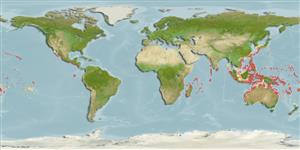Classification / Names
Common names from other countries
Main reference
Size / Weight / Age
Max length : 4.6 cm SL male/unsexed; (Ref. 48444)
Environment
Marine; reef-associated; depth range 1 - 30 m (Ref. 90102)
Climate / Range
Subtropical, preferred ?
Distribution
Indo-West Pacific: Maldives to New Caledonia, north to southern Japan. Recently recorded from Tonga (Ref. 53797).
Countries | FAO areas | Ecosystems | Occurrences | Introductions
Short description
Dorsal
spines
(total): 7;
Dorsal
soft rays
(total): 9-10;
Anal
spines: 1;
Anal
soft rays: 9. Thick dark bar under the eye, a short dark bar on the tail base, and a black spot at the front of first dorsal fin (Ref. 37816); characterized further by prolonged fourth dorsal spine, forming long filament in adult; longitudinal scale series 24; ctenoid scales on body, becoming cycloid anterior to pelvic and pectoral fins; 3-7 spines on rear edge of preopercle, lowermost often larger than others; rounded caudal fin; depth of body 3.7-4.0 in SL (Ref. 90102).
IUCN Red List Status (Ref. 115185)
Threat to humans
Harmless
Human uses
More information
Common namesSynonymsMetabolismPredatorsEcotoxicologyReproductionMaturitySpawningFecundityEggsEgg development
ReferencesAquacultureAquaculture profileStrainsGeneticsAllele frequenciesHeritabilityDiseasesProcessingMass conversion
Tools
Special reports
Download XML
Internet sources
Estimates of some properties based on models
Phylogenetic diversity index
PD50 = 0.5039 many relatives (e.g. carps) 0.5 - 2.0 few relatives (e.g. lungfishes)
Trophic Level
3.7 ±0.5 se; Based on size and trophs of closest relatives
Resilience
High, minimum population doubling time less than 15 months (Preliminary K or Fecundity.)
Vulnerability
Low vulnerability (12 of 100)
Price category
